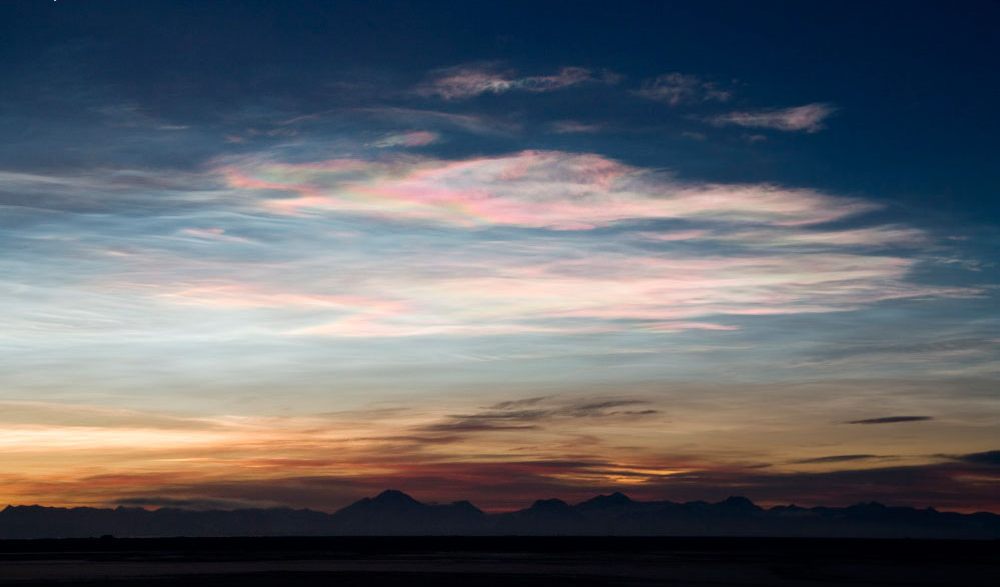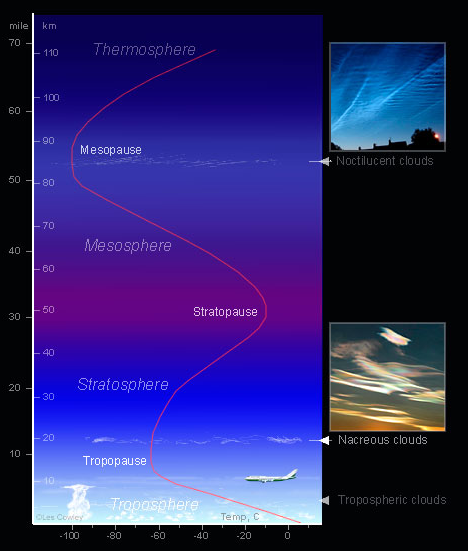OPOD - Greenland Nacreous Clouds
OPOD - Greenland Nacreous Clouds: A Spectacular Phenomenon in the Polar Stratosphere
Greenland Nacreous Clouds, also known as polar stratospheric clouds (PSCs), are a rare and awe-inspiring atmospheric optical phenomenon. While most clouds are found in the lower atmosphere, these unique clouds occur at higher altitudes, typically between 15 and 25 kilometers (9 - 16 miles) above the Earth's surface. They form during temperature minima, where the warmer and lower troposphere meets the increasingly hot stratosphere, heated by the absorption of solar UV radiation by ozone.
The Rarity and Formation of PSCs
PSCs are a rare sight, requiring specific conditions to form. They necessitate temperatures of less than -85°C (-121°F) and are therefore mostly confined to high geographic latitudes and the winter season. These clouds also require water vapor, which can be associated with stormy conditions or when vapor is lifted up from the lower troposphere, often occurring downstream of mountain ranges. PSCs can have exotic compositions, consisting of ice crystals, droplets, or crystals of nitric and sulfuric acid compounds.
The Enchanting Nacreous Clouds
Among PSCs, nacreous clouds stand out as the most vibrant and colorful. When observed during the night side of twilight, these clouds blaze with an otherworldly display of colors, reminiscent of being electrically lit. The colors exhibited by nacreous clouds are a result of iridescence caused by the diffraction of light from the many small ice crystals present within them.
Unforgettable Displays and Unique Characteristics
Nacreous clouds are a type of wave cloud, characterized by their filmy shapes that slowly curl and uncurl in the upper atmosphere winds and waves. Once witnessed, their captivating beauty leaves an indelible impression on the viewer. The intricate interplay of light and ice crystals creates a mesmerizing visual spectacle that is unlike any other natural phenomenon.
Observing Greenland Nacreous Clouds
Greenland, with its vast polar expanse, offers a unique opportunity to witness these extraordinary displays of nacreous clouds. In particular, Ittoqqortormiit (Scoresbysund) in Eastern Greenland has been a hotspot for capturing stunning images of these elusive clouds. Photographers, such as Tina Olholm from Denmark, have been fortunate enough to document the breathtaking beauty of Greenland's nacreous clouds.
The Significance of Nacreous Clouds
While nacreous clouds are undoubtedly a breathtaking sight, they also hold scientific importance. Their presence indicates the presence of very cold temperatures in the stratosphere, which can lead to the formation of ozone holes. These clouds provide valuable insights into atmospheric processes and help researchers better understand the dynamics of our Earth's atmosphere.
Conclusion
Greenland Nacreous Clouds, or polar stratospheric clouds, are a rare and captivating atmospheric phenomenon. Their formation requires specific temperature and moisture conditions, making them primarily visible in high latitudes during the winter season. Among PSCs, nacreous clouds stand out with their vibrant colors and mesmerizing displays. Observing these ethereal clouds in Greenland is a remarkable experience that leaves an unforgettable impression. Beyond their beauty, nacreous clouds also contribute to scientific research by providing valuable insights into atmospheric processes. Next time you find yourself gazing at the twilight sky, keep an eye out for these enchanting and elusive Greenland Nacreous Clouds.

Greenland Nacreous Clouds ~ Imaged at Ittoqqortormiit (Scoresbysund) in Eastern Greenland on 5th December 2010 by Tina Olholm of Denmark. ©Tina Olholm, shown with permission.

Nearly all our clouds are confined to the lower atmosphere, the troposphere. Two rare types of cloud are seen at higher altitudes. Both occur at, or near, temperature minima.
The highest are noctilucent or ‘night shining’ clouds at 80-85 km high (50-53 mile) and at a temperature of less than -123°C. They are composed of extremely small ice crystals, too small to show iridescent colours
The lower (and rarer) clouds are PSCs (Polar Stratospheric Clouds) and colourful nacreous clouds are a particular variety of them. They are 15 - 25 km (9 -16 mile) high in a temperature minimum between the warmer and lower troposphere and an increasingly hot stratosphere heated from the absorption of solar UV radiation by ozone.
PSCs need temperatures of less than -85°C to form and so are confined to high geographic latitudes and winter. They also need water vapour and can therefore be associated with very stormy conditions or downstream of mountain ranges when vapour is lofted up from the troposphere.
PSCs can be of exotic composition. Nacreous clouds are of friendly ice crystals but others are droplets or crystals of nitric and sulphuric acid compounds.
Nacreous clouds are the most colourful of the PSCs. On the night side of twilight they blaze with colour as though electrically lit. The colours are iridescence caused by diffraction from the many small ice crystals. Nacreous clouds are wave clouds and if you are fortunate to see them, watch for as long as possible to see their filmy shapes slowly curl and uncurl in the upper atmosphere winds and waves.
Once seen they are unforgettable.
Note: this article has been automatically converted from the old site and may not appear as intended. You can find the original article here.
Reference Atmospheric Optics
If you use any of the definitions, information, or data presented on Atmospheric Optics, please copy the link or reference below to properly credit us as the reference source. Thank you!
-
<a href="https://atoptics.co.uk/blog/opod-greenland-nacreous-clouds/">OPOD - Greenland Nacreous Clouds</a>
-
"OPOD - Greenland Nacreous Clouds". Atmospheric Optics. Accessed on November 26, 2024. https://atoptics.co.uk/blog/opod-greenland-nacreous-clouds/.
-
"OPOD - Greenland Nacreous Clouds". Atmospheric Optics, https://atoptics.co.uk/blog/opod-greenland-nacreous-clouds/. Accessed 26 November, 2024
-
OPOD - Greenland Nacreous Clouds. Atmospheric Optics. Retrieved from https://atoptics.co.uk/blog/opod-greenland-nacreous-clouds/.